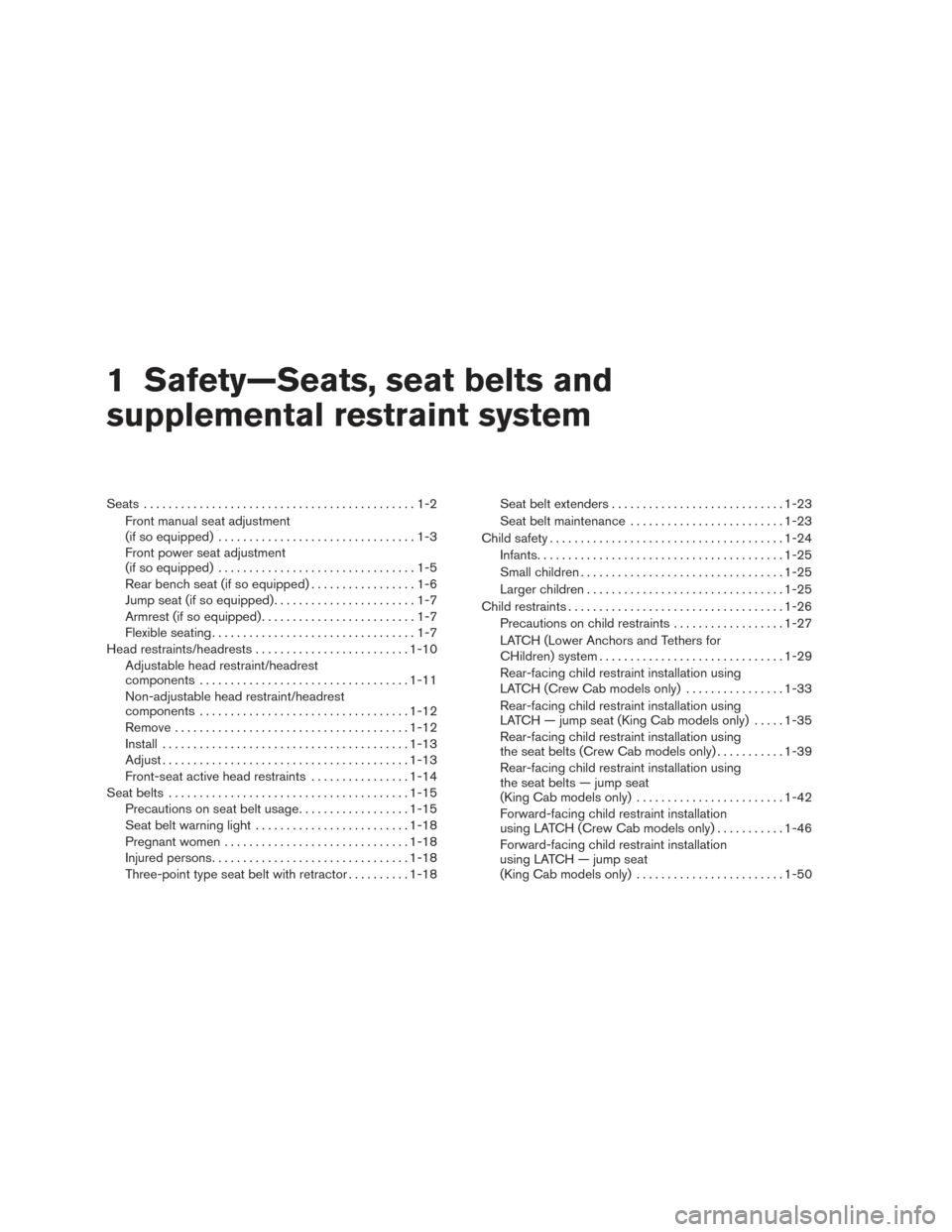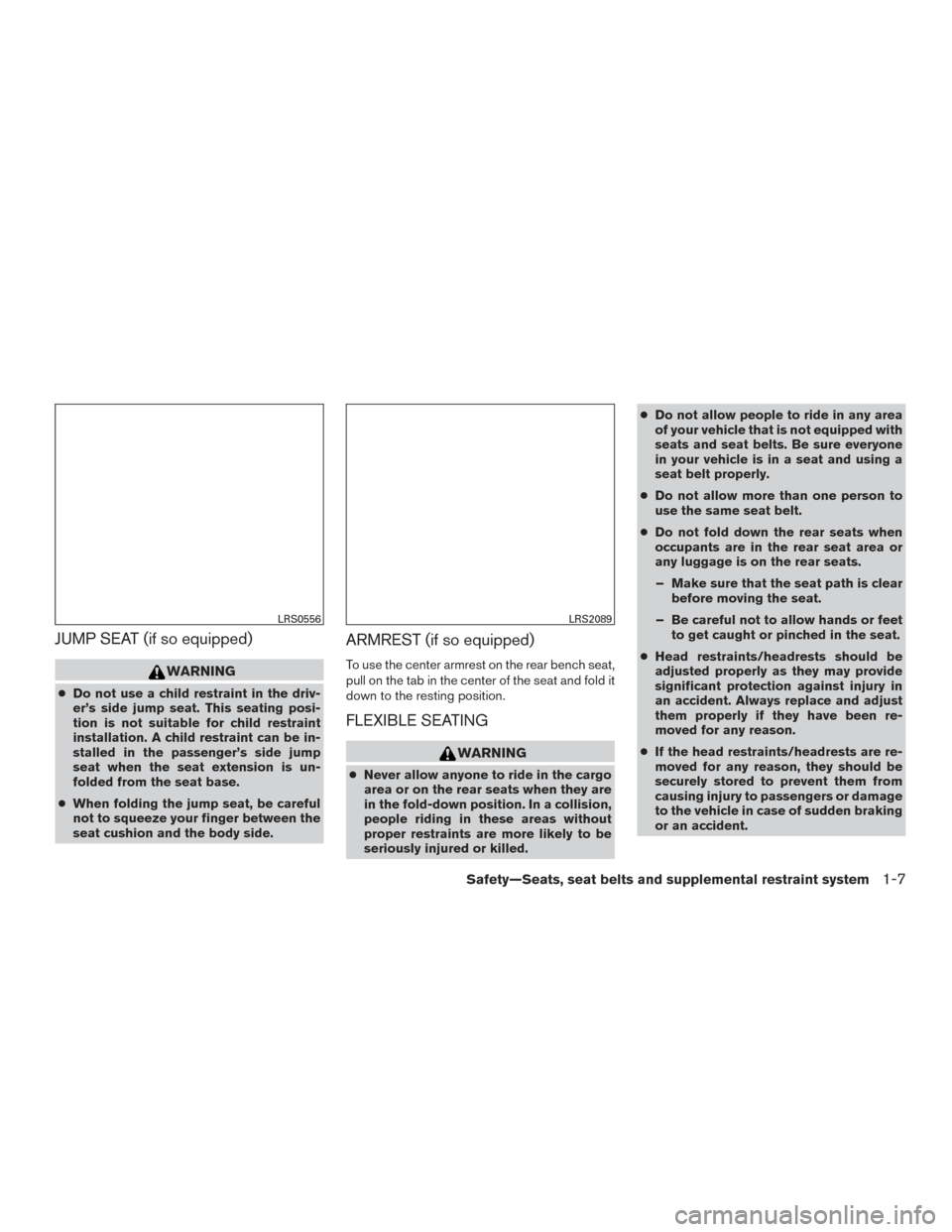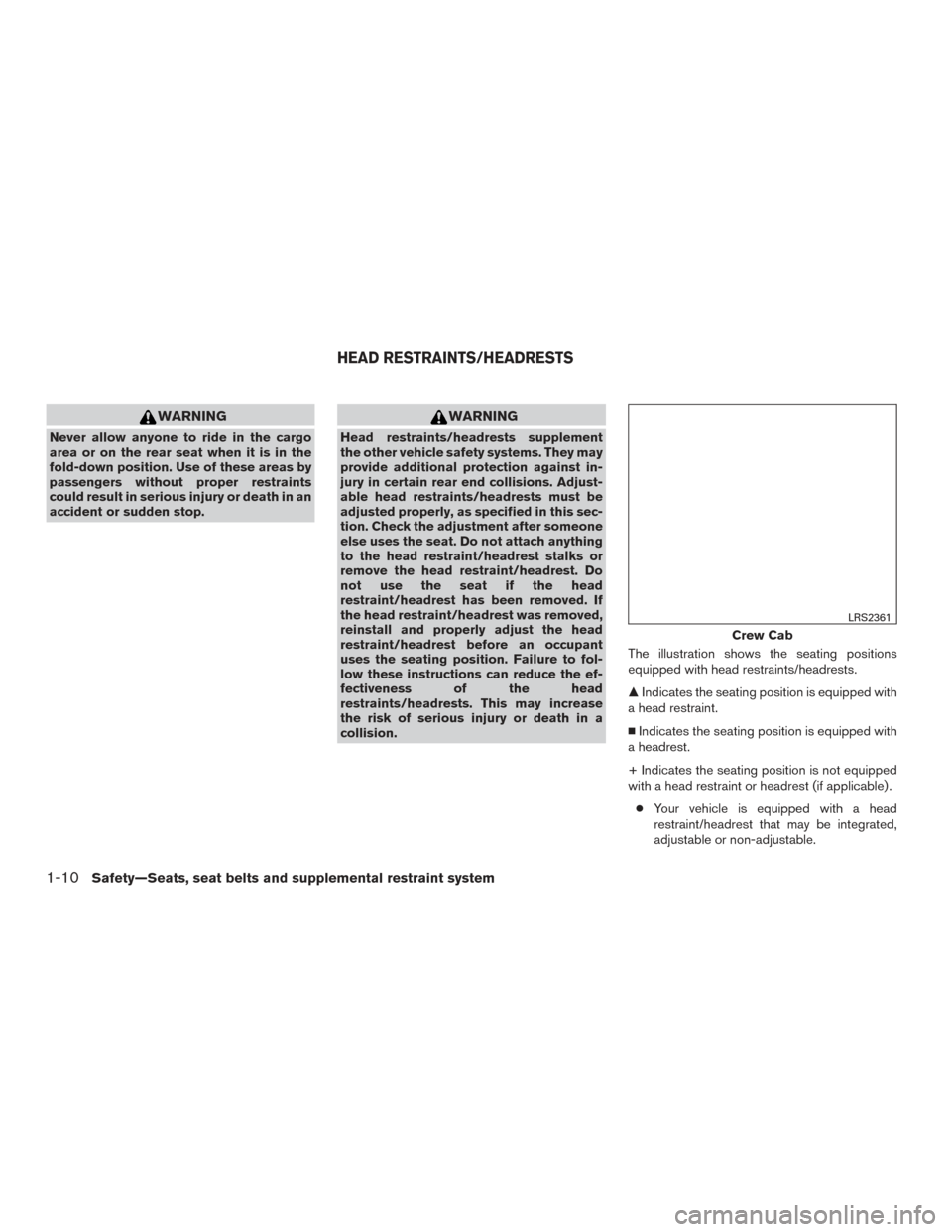Page 11 of 469
1. Rear seat belts (P. 1-15)
2. Roof-mounted curtain side-impact androllover supplemental air bag (P. 1-70)
3. Head restraints/headrests (P.1-10)
4. Front seat belts with pretensioner(s)
and shoulder height adjuster
(P. 1-15, 1-70)
5. Supplemental front-impact air bags
(P.1-70)
6. Seats (P. 1-2)
7. Occupant classification sensor
(pressure sensor) (P. 1-70)
8. Front seat-mounted side-impact
supplemental air bag (P. 1-70)
9. LATCH (Lower Anchors and Tethers for
CHildren) system (P. 1-26)
10. Top tether strap anchor (P. 1-26)
Refer to the page number indicated in pa-
rentheses for operating details.
LII2310
AIR BAGS, SEAT BELTS AND CHILD
RESTRAINTS
0-2Illustrated table of contents
Page 21 of 469

1 Safety—Seats, seat belts and
supplemental restraint system
Seats............................................1-2
Front manual seat adjustment
(if so equipped) ................................1-3
Front power seat adjustment
(if so equipped) ................................1-5
Rear bench seat (if so equipped) .................1-6
Jump seat (if so equipped) .......................1-7
Armrest (if so equipped) .........................1-7
Flexible seating .................................1-7
Head restraints/headrests ......................... 1-10
Adjustable head restraint/headrest
components .................................. 1-11
Non-adjustable head restraint/headrest
components .................................. 1-12
Remove ...................................... 1-12
Install ........................................ 1-13
Adjust ........................................ 1-13
Front-seat active head restraints ................1-14
Seat belts ....................................... 1-15
Precautions on seat belt usage ..................1-15
Seat belt warning light ......................... 1-18
Pregnant women .............................. 1-18
Injured persons ................................ 1-18
Three-point type seat belt with retractor ..........1-18 Seat belt extenders
............................ 1-23
Seat belt maintenance ......................... 1-23
Child safety ...................................... 1-24
Infants ........................................ 1-25
Small children ................................. 1-25
Larger children ................................ 1-25
Child restraints ................................... 1-26
Precautions on child restraints ..................1-27
LATCH (Lower Anchors and Tethers for
CHildren) system .............................. 1-29
Rear-facing child restraint installation using
LATCH (Crew Cab models only) ................1-33
Rear-facing child restraint installation using
LATCH — jump seat (King Cab models only) .....1-35
Rear-facing child restraint installation using
the seat belts (Crew Cab models only) ...........1-39
Rear-facing child restraint installation using
the seat belts — jump seat
(King Cab models only) ........................ 1-42
Forward-facing child restraint installation
using LA
TCH (Crew Cab models only) ...........1-46
Forward-facing child restraint installation
using LATCH — jump seat
(King Cab models only) ........................ 1-50
Page 28 of 469

JUMP SEAT (if so equipped)
WARNING
●Do not use a child restraint in the driv-
er’s side jump seat. This seating posi-
tion is not suitable for child restraint
installation. A child restraint can be in-
stalled in the passenger’s side jump
seat when the seat extension is un-
folded from the seat base.
● When folding the jump seat, be careful
not to squeeze your finger between the
seat cushion and the body side.
ARMREST (if so equipped)
To use the center armrest on the rear bench seat,
pull on the tab in the center of the seat and fold it
down to the resting position.
FLEXIBLE SEATING
WARNING
●Never allow anyone to ride in the cargo
area or on the rear seats when they are
in the fold-down position. In a collision,
people riding in these areas without
proper restraints are more likely to be
seriously injured or killed. ●
Do not allow people to ride in any area
of your vehicle that is not equipped with
seats and seat belts. Be sure everyone
in your vehicle is in a seat and using a
seat belt properly.
● Do not allow more than one person to
use the same seat belt.
● Do not fold down the rear seats when
occupants are in the rear seat area or
any luggage is on the rear seats.
– Make sure that the seat path is clear before moving the seat.
– Be careful not to allow hands or feet to get caught or pinched in the seat.
● Head restraints/headrests should be
adjusted properly as they may provide
significant protection against injury in
an accident. Always replace and adjust
them properly if they have been re-
moved for any reason.
● If the head restraints/headrests are re-
moved for any reason, they should be
securely stored to prevent them from
causing injury to passengers or damage
to the vehicle in case of sudden braking
or an accident.
LRS0556LRS2089
Safety—Seats, seat belts and supplemental restraint system1-7
Page 31 of 469

WARNING
Never allow anyone to ride in the cargo
area or on the rear seat when it is in the
fold-down position. Use of these areas by
passengers without proper restraints
could result in serious injury or death in an
accident or sudden stop.
WARNING
Head restraints/headrests supplement
the other vehicle safety systems. They may
provide additional protection against in-
jury in certain rear end collisions. Adjust-
able head restraints/headrests must be
adjusted properly, as specified in this sec-
tion. Check the adjustment after someone
else uses the seat. Do not attach anything
to the head restraint/headrest stalks or
remove the head restraint/headrest. Do
not use the seat if the head
restraint/headrest has been removed. If
the head restraint/headrest was removed,
reinstall and properly adjust the head
restraint/headrest before an occupant
uses the seating position. Failure to fol-
low these instructions can reduce the ef-
fectiveness of the head
restraints/headrests. This may increase
the risk of serious injury or death in a
collision.The illustration shows the seating positions
equipped with head restraints/headrests.
�
Indicates the seating position is equipped with
a head restraint.
� Indicates the seating position is equipped with
a headrest.
+ Indicates the seating position is not equipped
with a head restraint or headrest (if applicable) .
● Your vehicle is equipped with a head
restraint/headrest that may be integrated,
adjustable or non-adjustable.
Crew Cab
LRS2361
HEAD RESTRAINTS/HEADRESTS
1-10Safety—Seats, seat belts and supplemental restraint system
Page 32 of 469
●Adjustable head restraints/headrests have
multiple notches along the stalk(s) to lock
them in a desired adjustment position.
● The non-adjustable head
restraints/headrests have a single locking
notch to secure them to the seat frame.
● Proper Adjustment:
– For the adjustable type, align the head restraint/headrest so the center of your
ear is approximately level with the center
of the head restraint/headrest. – If your ear position is still higher than the
recommended alignment, place the head
restraint/headrest at the highest position.
● If the head restraint/headrest has been re-
moved, ensure that it is reinstalled and
locked in place before riding in that desig-
nated seating position.ADJUSTABLE HEAD RESTRAINT/
HEADREST COMPONENTS
1. Removable head restraint/headrest
2. Multiple notches
3. Lock knob
4. Stalks
King Cab
LRS2362LRS2300
Safety—Seats, seat belts and supplemental restraint system1-11
Page 33 of 469
NON-ADJUSTABLE HEAD
RESTRAINT/HEADREST
COMPONENTS
1. Removable head restraint/headrest
2. Single notch
3. Lock knob
4. Stalks
REMOVE
Use the following procedure to remove the head
restraint/headrest:1. Pull the head restraint/headrest up to the highest position.
2. Push and hold the lock knob.
3. Remove the head restraint/headrest from the seat.
4. Store the head restraint/headrest properly in a secure place so it is not loose in the
vehicle. 5. Reinstall and properly adjust the head
restraint/headrest before an occupant uses
the seating position.
LRS2299LRS2302
1-12Safety—Seats, seat belts and supplemental restraint system
Page 34 of 469
INSTALL
1. Align the head restraint/headrest stalks withthe holes in the seat. Make sure that the
head restraint/headrest is facing the correct
direction. The stalk with the notch (notches)
�1must be installed in the hole with the lock
knob
�2.
2. Push and hold the lock knob and push the head restraint/headrest down.
3. Properly adjust the head restraint/headrest before an occupant uses the seating posi-
tion.
ADJUST
For adjustable head restraint/headrest
Adjust the head restraint/headrest so the center
is level with the center of your ears. If your ear
position is still higher than the recommended
alignment, place the head restraint/headrest at
the highest position. For non-adjustable head restraint/headrest
Make sure the head restraint/headrest is posi-
tioned so the lock knob is engaged in the notch
before riding in that designated seating position.
LRS2303WRS0134LRS2351
Safety—Seats, seat belts and supplemental restraint system1-13
Page 35 of 469
Raise
To raise the head restraint/headrest, pull it up.
Make sure the head restraint/headrest is posi-
tioned so the lock knob is engaged in the notch
before riding in that designated seating position.
Lower
To lower, push and hold the lock knob and push
the head restraint/headrest down.
Make sure the head restraint/headrest is posi-
tioned so the lock knob is engaged in the notch
before riding in that designated seating position.
FRONT-SEAT ACTIVE HEAD
RESTRAINTS
WARNING
●Always adjust the head restraints prop-
erly as specified in this section. Failure
to do so can reduce the effectiveness of
the active head restraint.
● Active head restraints are designed to
supplement other safety systems. Al-
ways wear seat belts. No system can
prevent all injuries in any accident.
LRS2305LRS2306SPA1025
1-14Safety—Seats, seat belts and supplemental restraint system